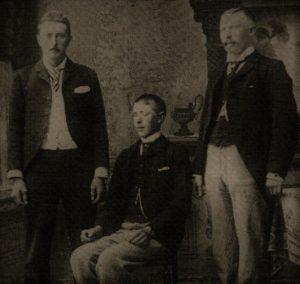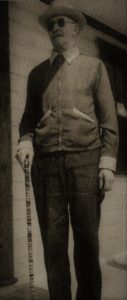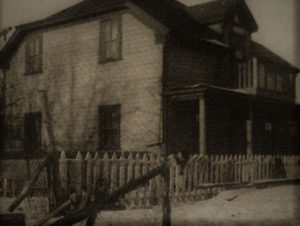
The brothers Grímur, Eiríkur, seated, and Stefán in light trousers Photo: WtW

Eiríkur with his hand-made walking stick. Photo: WtW
Eiríkur Jónsson Scheving went west to Winnipeg, Manitoba at the age of 14 and stayed with his brother, Stefán, a shoe maker, who went there in 1887. Eiríkur was born poor vision and hoped to find healing in the West. He did not find help and by the early 20th century he was blind. His two cousins, Högni and Eiríkur Guðmundsson, traveled west with him in 1889 and they both settled in the Lundar settlement. Högni’s daughter, Björg, b. On July 22, 1890, married Björn Björnsson from N. Múlasýsla in 1910 and they lived in the Lundar settlement on the land called Laufás. They provided Eiríkur with shelter and he enjoyed his time there. He was artistic and made things out of horn, metal and wood. His works were recognized at various exhibitions in Canada. He was also a musician and played the violin, organ and flute beautifully. He enjoyed writing poetry, wrote a lot himself, and verses and poems by him appeared in Icelandic newspapers and western magazines. He was actively involved in social affairs in the Lundar settlement, was in the Icelandic National League and sang in the church choir. Sigurður Baldvinsson* met Eiríkur and wrote about him in the Almanak in 1944. It says:
“Eiríkur Jónsson Scheving, son of Einarsson Stefánsson, priest at Presthólar, Lárusson, convent steward, Hannesson, magistrate, Lavrensson, magistrate in Eyjafjörður, from Scheving in Jótland, was born in Hólaland in eastern Borgarfjörður on November 11, 1874. His mother is Guðný Eiríksdóttir, Jónsson from Hleinargerði in Eyðaþinghá. He grew up with his parents until the age of 14, then he went to America and sought out his brother Stefán, who had moved here a few years before, and was living in Winnipeg.
Eiríkur had the misfortune of losing sight in both eyes at the age of two, but still had a little sight until the age of 30. Then he became completely blind, and the reason why he went to America at such a young age was that he expected that the doctors here would be able to cure his blindness. But despite their many attempts, there was no result to his benefit. When Eiríkur saw that there was no hope of recovery from his blindness, he turned to his cousins, Eiríkur and Högni, farmers in Laufás near Lundar. He was well-received and lived in the home of those brothers until they both died, and since then he has stayed with Björg, daughter of Högni, wife of farmer Björn Björnsson in Laufás, always treated well and respectfully, as if he were from the family. Eiríkur has done a lot of work in his home because he is eminently skilled in wood, horn and metal. In my opinion, Eiríkur is highly gifted like his elder ancestors. He can read with his fingertips the raised runes of blind people as quickly as the average person does ordinary letters and can therefore acquire great knowledge in the darkness at his table. He plays pretty well on the violin and organ and sings in the church at Lundar during masses, at full volume.
Eiríkur has made many household items and all of them with prowess, and several walking sticks from steel and horn, so skillfully made that I have never seen such a work of art of that kind, and people have paid as much as $50.00 for them. The stick that he walks by every day should be in the National Museum of Iceland, as it is skillfully carved from black buffalo horn and bull’s horn. Now Eiríkur is 65 years old, but brave and vigorous, and walks straight through the streets of Lundar with his cane, as wise as those who have full sight. He is knowledgeable and truthful about many things. I have talked about Scheving because I think he is an admirably well-rounded man. He handles his adversity well, and has shown us that he has overcome it, but it did not bend him. Namely, he has done the works without sight, which few people could have done with full sight.”

Laufás in Lundar settlement Photo WtW
*Sigurður Baldvinsson went west to Winnipeg, Manitoba in 1902 and took land in northern Lake Manitoba.
